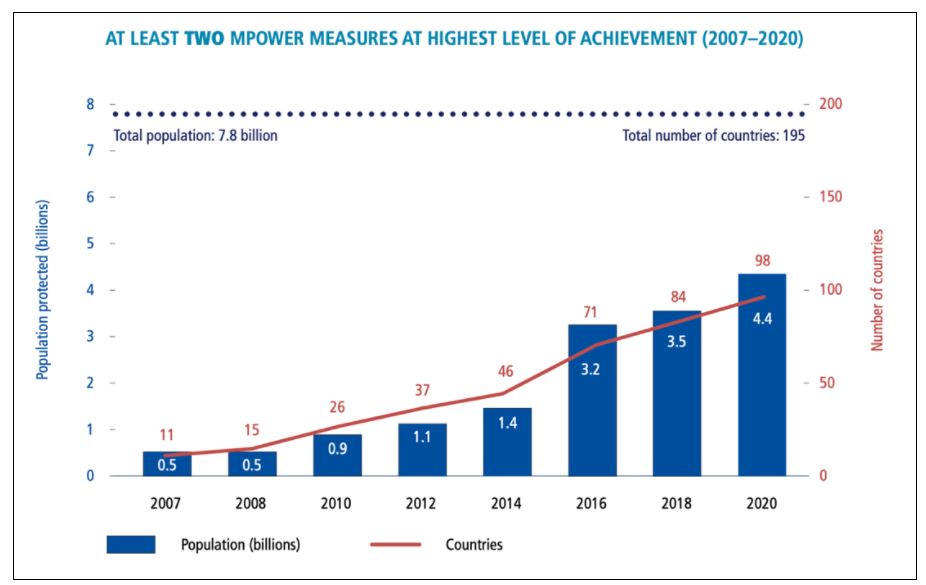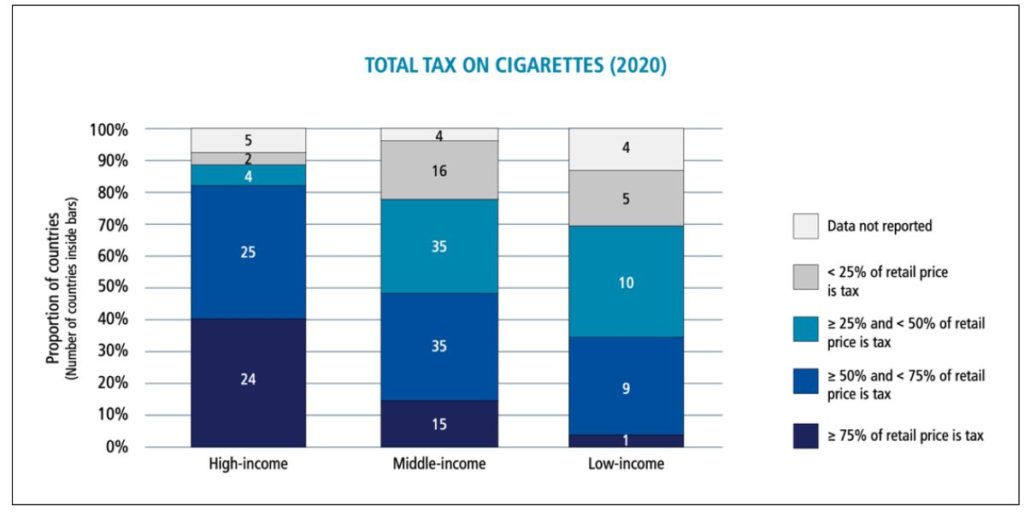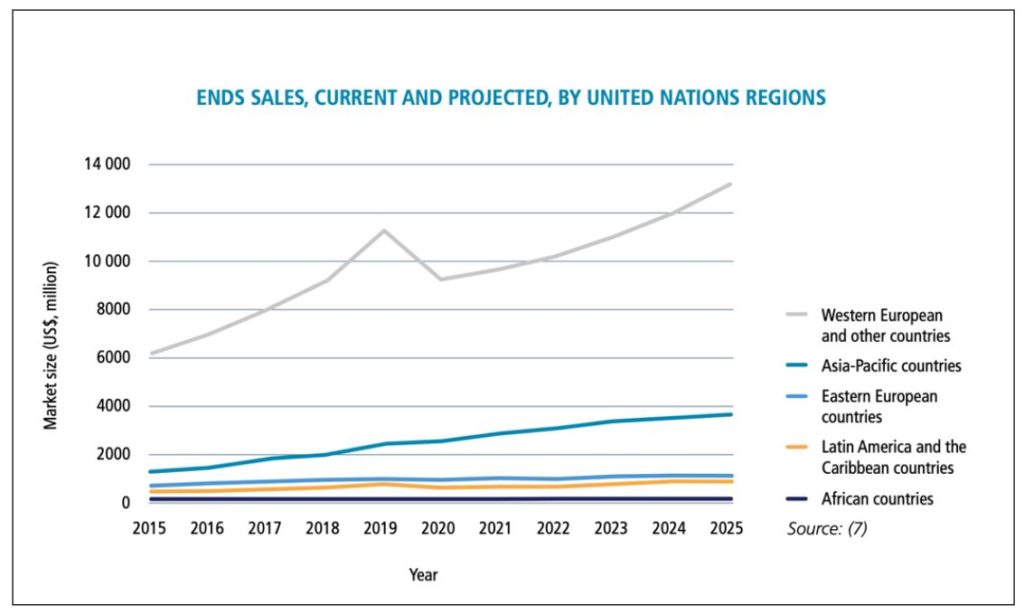One of the targets under the Sustainable Development Goals (SDGs) is to strengthen the implementation of the WHO ‘Framework Convention on Tobacco Control’ in all countries. The latest WHO report on tobacco control points out that while most countries are implementing tobacco control measures, there is a need to address ‘New and Emerging Products’.
Tobacco usage poses serious health hazards. Tobacco use accounts for 71% of non-communicable deaths worldwide. Hence, reducing tobacco use is critical to reducing the burden of non-communicable diseases across the world. A few of the diseases that are attributed to tobacco include – lung & heart diseases, chronic respiratory diseases, cancers & diabetes. All of these are co-morbidities that could increase the probability of severe infection with COVID-19 leading to even death. Hence, in the context of the COVID-19 pandemic, safeguarding the population from the harmful effects of tobacco assumes greater importance than earlier.
The implementation of the WHO Framework convention on Tobacco Control (WHO FCTC) is now considered a global development priority and is a dedicated target in the Sustainable Development Goals.
The World Health Organization (WHO) has earlier released – WHO Report on Global Tobacco Epidemic 2019. The main purpose of the report is to track the Tobacco epidemic and the interventions to combat it. Since then, the global landscape has changed due to the COVID-19 pandemic, raising apprehensions on its impact on the initiatives to combat tobacco usage.
Recently, WHO released the eighth edition of the WHO report on the Global Tobacco Epidemic 2021. The theme of the report is ‘Addressing New and Emerging Products’ that provides insights into the progress made globally in combating tobacco usage and the impact COVID-19 might have had on it. In this story, we review a few of the key highlights from this report.
146 countries & around 5.3 billion people covered by at least one MPOWER measure
As highlighted earlier, WHO FCTC lays down the guidelines that act as the foundation for the countries to implement & manage tobacco control. To facilitate the implementation, WHO introduced MPOWER. The implementation of these measures will help the countries create effective interventions in tobacco usage and reduce its demand.
The latest data for 2020 indicates that 146 countries are covered under at least one MPOWER measure at the highest level. Despite the COVID-19 pandemic, 7 additional countries have managed to reach this criterion compared to 2018. There has been steady progress in the number of countries which have adopted and reached the highest level for at least one measure to combat the usage of tobacco. In 2007, only 44 countries were covered. The highest increase was during 2014-16 when the coverage increased from 107 countries in 2014 to 124 by 2016.
An increase in the number of countries implies that a greater population has come under the coverage of any one measure of MPOWER. By 2020, around 5.3 billion people were covered under at least one measure of MPOWER at the highest level.
Apart from the considerable progress in making new countries achieve the highest level in the implementation of at least one measure, there has also been significant improvement in the number of countries that have managed to meet the highest levels for two measures in controlling usage of tobacco.
- As of 2020, 98 countries i.e., around half of the countries have managed to achieve the highest levels for two measures. These countries constitute a population of around 4.4 billion. As of 2008, only half a billion population were covered under at least two measures.
- Even in this case, the significant improvement was during the 2014-16 period. The growth rate during 2018-2020 was higher than the earlier two-year period i.e., 2016-18, highlighting that the COVID-19 pandemic might not have had a severe impact on the measures taken by various governments to combat the usage of tobacco.
- Of these 98 countries, at least 31 countries have managed to reach the highest levels in 3 measures of MPOWER.
- 5 countries – Jordan, Ireland, Madagascar, New Zealand & Spain have managed to achieve the highest levels for four measures.
- Two countries i.e., Brazil & Turkey are the only ones who have implemented the best practices across all the MPOWER measures.
‘Pack Warnings’ constitutes the control measure with the highest coverage of the population
A total of 101 countries have implemented complete policies with respect to ‘Pack Warnings’ as a measure to deter the consumption of tobacco products. Providing warnings on the packs of tobacco products is part of the larger measure of “Warn against the dangers of tobacco” (W) under MPOWER.
The other measure under W is the warnings through mass media. 46 countries have comprehensive policies in place regarding the usage of mass media as a control measure. However, 103 countries do not have a policy in place or have a weak policy.
In terms of population, an additional 55% of the population is covered under the measure of ‘Pack Warnings’ as of 2020 compared to 2007, when it was only 5%. In 2007, the highest percentage of the population was covered under the measure of mass media with 32% with only an additional of 11% by 2020.
Another measure which has witnessed significant improvement over the recent years is ‘Monitoring’. In 2007, only 19% of the population was covered under this measure while an additional 38% were covered by 2020. Around 78 countries have recent or periodic data of both adults & youth, aiding in the monitoring of the prevalence of tobacco consumption.
Taxation continues to be the least implemented measure as a deterrent for the consumption of tobacco products. Around 40 countries have complete policies in place to use ‘Taxation’ as a viable measure whereas 69 countries have moderate and 49 countries have minimal policies in place. In terms of population, around 7% was covered in 2007 with an addition only 6% by 2020.
Increased taxation as an effective measure to combat the use of Tobacco products
As per Article 6 of the WHO FCTC, Price & Tax measures are effective measures to control tobacco consumption. It suggests the implementation of tax policies and price policies on tobacco products. The report cites the observations of ‘Task Force on Fiscal Policy for Health’, who in their report state that Tax increases would lead to an increase of tobacco prices by 50% and increased prices could contribute towards averting 27.2 million premature deaths worldwide in the next 50 years.
Taxation and Pricing policy are also less expensive to implement, which would help low- & middle-income countries to opt for this measure to control the consumption of tobacco. Higher tax & pricing policy could also contribute towards increased revenue to the government, albeit the main target being the increased price to act as a deterrent.
As per the observations of the Task Force, an increase of 10% in price in low- & middle-income countries would bring down the consumption by 5% and can reach up to 8% as well in certain situations. Among high-income countries, in around 40% of the counties (24 countries), Tax constitutes more than 75% of the retail price of cigarettes, with around another 25 high-income countries having taxes up to 50-75% of the total retail price.
In the case of Middle-income counties, only 15 countries out of 105 have tax at more than 75% of the retail price. This is much lower in lower-income countries with only 1 out of 29 lower-income countries having a tax regimen, that has more than 75% tax as part of the retail price. Another 9 low-income countries have taxes at 50-75 % of the retail price of cigarettes.
This indicates a huge scope for middle- & low-income countries to increase the levels of taxation on tobacco products, which could act as an effective means of reducing usage. However, it ought to be noted that the tax revenue on tobacco products also forms a key part of the revenue for many of the low- & middle-income countries, and hence these countries are wary of losing out on the revenue in case the prices are beyond reach and the population not consuming the tobacco products.
What is the tax revenue through Tobacco products in India?
As far as India is concerned, as per an update provided in Rajya Sabha in August 2021, the average annual revenue collected (including GST, Compensation Cess, Excise duty, and National Calamity and Contingent Duty (NCCD)), on tobacco products is about Rs. 53.7 thousand crores. Highlighting the different measures taken by the government to curb the usage of Tobacco products, the government stated in another response in Rajya Sabha that all the tobacco products are covered under the highest slab under GST, with an additional compensation Cess. However, bidis are excluded from the same. As per the data available with ‘The Tobacco Institute of India’, a representative body, the total tax collected on tobacco products is around Rs. 43 thousand crores, of which the maximum is through Cigarettes. Cigarettes which constitute only 9% of the total tobacco consumption contribute nearly 80 % of the total tax revenue through tobacco products.
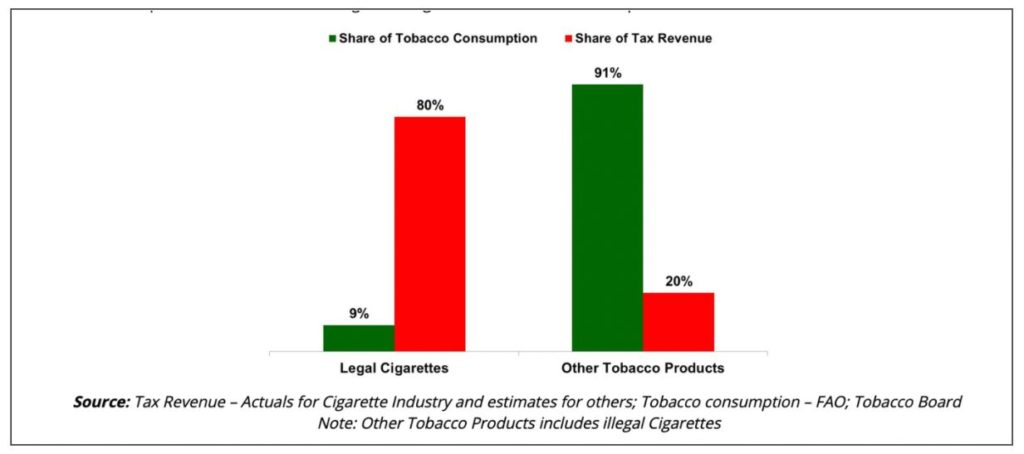
While the tax policy on cigarettes seems to be in line with the measures of increased taxation to deter the consumers, a large portion of the tobacco products are left out. A larger share of tobacco users is under the non-cigarette category. A higher tax on these products could help in reducing their consumption.
The report highlights the need to control alternative & emerging tobacco products
The theme of ‘World Report on Global Tobacco Epidemic – 2021’, is addressing ‘New & Emerging products’. With control is being exercised by most countries to curb the use of tobacco products, there are new products being introduced that are beyond the definition of tobacco products. Hence, the report highlights the need to identify such products and bring in restrictions. The biennial Conference of Parties (COP) under WHO FCTC has provided guidelines to regulate the usage of these novel products.
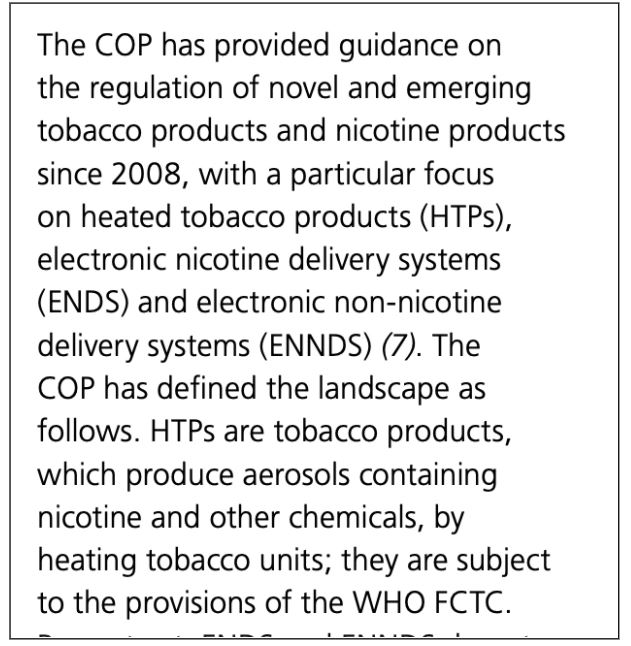
In 2018, COP 8 has defined Heated Tobacco Products (HTPs) as Tobacco Products and hence fall under the provisions of WHO FCTC. The sale of ENDS (Electronic Nicotine Delivery Systems) is high in Western European countries and there has been an increase in their usage over the years.
While the long-term health effects of ENDS are not known, there is growing evidence to demonstrate that these products are not harmless. The diversity of ENDS makes it a challenge to monitor & regulate the products. It ought to be noted that India has banned the usage of E-Cigarettes in 2019, through an ordinance.
Featured Image: Tobacco control measures




